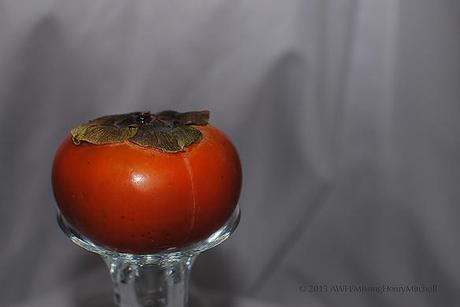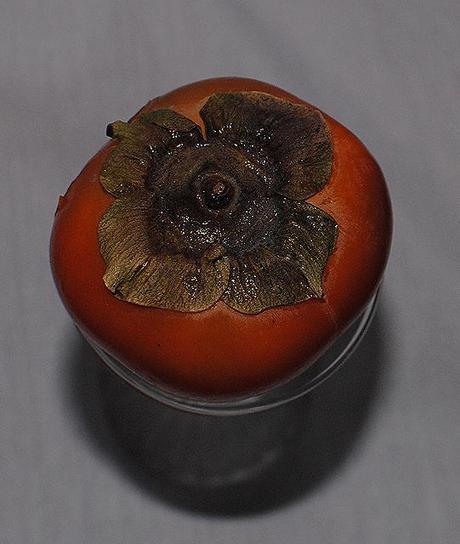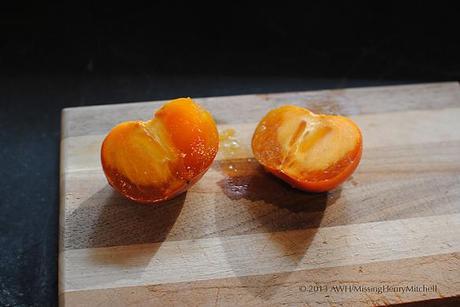I have been reading and rereading Lee Reich’s Uncommon Fruits for Every Garden, becoming increasingly obsessed with acquiring and growing fruits unknown or forgotten. One of the fruits Reich recommends is the persimmon.

He discusses two types: American persimmon, Diospyros virginiana and the kaki persimmon, Diospyros kaki. He claims that a few people grow the kaki persimmon, and that the American persimmon is virtually unheard of.
Not ’round here, where they are native if not widely cultivated. I remember eating persimmons as a young child–my neighbor had a tree, and my friends and I ate them when they fell to the ground if the bees, bugs, and squirrels didn’t get to them first. I remember them being sticky, squishy, and delicious, with rich juice coating my fingers (and arms, and legs).
Unknown, no; but forgotten–I can confess to that. It has been 30 years, easily, since I last ate one out of hand. But in the grocery store last week, what should be on display but a tower of ‘Fuyu’ persimmons.

The ‘Fuyu’ is a kaki cultivar. It is non-astringent, which is an important quality to be aware of before embarking upon persimmon-based culinary adventures. As I can attest from youthful experience, eating even slightly unripened fruits is ill-advised. In an interview, Reich compared the experience of eating an unripened astringent persimmon to putting a vacuum cleaner into one’s mouth. That’s pretty accurate. I think I remember a searing sensation just below the hinges of my jawbone and then panicking as my face fought the force of a black hole. I never tried that again. Experience, you are the greatest teacher.
Persimmons, when at their best, should feel like a tomato you wouldn’t buy because it wouldn’t make it home from the market unless swaddled in bubble wrap. You can feel the fruit’s skin only just containing the juice. Then, they taste like perfection. Richer than black plum but with a similar texture, it tastes to me like honey mixed with a healthy dollop of apple butter. Reich describes it as “something like a wet, dried apricot that has been drizzled with honey and given a dash of spice.”

Hardy in USDA Zones 7-10 (tolerating winter lows of 10F or -12C), ‘Fuyu’ persimmons are seedless and do not require cross-pollination. More hardy varieties of kaki persimmon, including ‘Saijo’ and ‘Sheng,’ can withstand winters in Zones 5 and 6 (-20F or -29C), and the American persimmon is hardier still, thriving in Zones 4b to 9.
After the first frost each year (which should happen for me this week), a local brewery makes a persimmon winter ale using foraged fruit of Diospyros virginiana. (The fruits of the American persimmon do not lose their vacuum-cleaner astringency until after frost.) It’s tasty if you enjoy a winter ale-type beer. My skills with comestibles do not extend to home brewing (a project for another season, perhaps?), but I do remember eating a heavenly persimmon pudding in my past. I think I’ll head to the farmer’s market this week to stock up on persimmons and see if this recipe comes close to what I remember.
Now, where to put my persimmon tree?
Sources for persimmon trees:
- Edible Landscaping
- Willis Orchards
- Chestnut Hill Tree Farm
- Trees of Antiquity
Tips on Growing Persimmons:
- Growing Oriental Persimmons in North Carolina
- Persimmons (from the Purdue Univ. Dept. of Horticulture)
- Common Persimmon (Univ. of Florida Extension)

